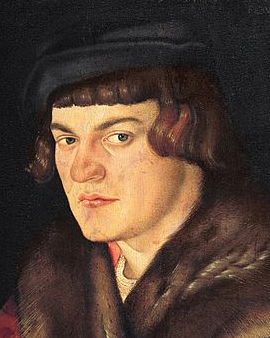


Hans Baldung was a German painter and printmaker and was considered one of the most talented and successful students of Albrecht Dürer. His artistic life's work comprises 90 paintings and altarpieces, around 350 drawings and 180 book illustrations. Baldung came from a family of intellectuals and academics. The majority of his relatives were doctors or lawyers. It was rather untypical at that time for the son of a purely academic family to pursue an artistic career. In fact, Hans Baldung was the only man in the family without a university degree and one of the first German artists from a purely academic family. Little is known about his early education. Since he grew up in Strasbourg, it is assumed that his first teacher must have been a painter from the region.
As was customary for journeymen of the time, Baldung also began his years of travel and left Strasbourg at the age of about 19. He moved to Nuremberg and was taken up in the workshop of Albrecht Dürer. Baldung soon began to absorb Dürer's influence and the two of them were bound together by a very deep friendship throughout their lives. Baldung probably took over the management of Dürer's workshop in Nuremberg when he made his second trip to Venice. According to documents, Dürer took some of Baldung's work with him on his trip and sold it for him. During his time with Dürer, Baldung received his nickname Grien. It was probably intended to make it easier to distinguish the various artists with the first name Hans in the workshop, such as Hans Schäufelein or Dürer's younger brother Hans. Later Baldung also signed his paintings with the initials HGB. Historians do not agree on the reason for this nickname. Some suspect it could be due to his special preference for the colour green, others see a connection to the word Grienhals, which means witch. For one of the central themes of his works, apart from religious motifs, was witchcraft, mystical, erotic depictions and later death. In Dürer's works there were always witches, but by far not as often as in Baldung's works.
After six years Baldung finally left Dürer's workshop. He returned to Strasbourg and was granted citizenship. Then he opened his own workshop and joined the local guild Zur Steltz. He soon became one of the most respected personalities in the city and was a much sought-after artist. Baldung married Margarethe Herlin, the daughter of a local merchant. The couple spent most of their life together in Strasbourg. For Baldung's largest commission in the course of his career, however, they moved temporarily to Freiburg im Breisgau, where he was to design the high altar of the Freiburg Cathedral, among other things. It took him almost four years to complete the project. Baldung became one of the wealthiest men in the city and a member of the Strasbourg city council.

Hans Baldung was a German painter and printmaker and was considered one of the most talented and successful students of Albrecht Dürer. His artistic life's work comprises 90 paintings and altarpieces, around 350 drawings and 180 book illustrations. Baldung came from a family of intellectuals and academics. The majority of his relatives were doctors or lawyers. It was rather untypical at that time for the son of a purely academic family to pursue an artistic career. In fact, Hans Baldung was the only man in the family without a university degree and one of the first German artists from a purely academic family. Little is known about his early education. Since he grew up in Strasbourg, it is assumed that his first teacher must have been a painter from the region.
As was customary for journeymen of the time, Baldung also began his years of travel and left Strasbourg at the age of about 19. He moved to Nuremberg and was taken up in the workshop of Albrecht Dürer. Baldung soon began to absorb Dürer's influence and the two of them were bound together by a very deep friendship throughout their lives. Baldung probably took over the management of Dürer's workshop in Nuremberg when he made his second trip to Venice. According to documents, Dürer took some of Baldung's work with him on his trip and sold it for him. During his time with Dürer, Baldung received his nickname Grien. It was probably intended to make it easier to distinguish the various artists with the first name Hans in the workshop, such as Hans Schäufelein or Dürer's younger brother Hans. Later Baldung also signed his paintings with the initials HGB. Historians do not agree on the reason for this nickname. Some suspect it could be due to his special preference for the colour green, others see a connection to the word Grienhals, which means witch. For one of the central themes of his works, apart from religious motifs, was witchcraft, mystical, erotic depictions and later death. In Dürer's works there were always witches, but by far not as often as in Baldung's works.
After six years Baldung finally left Dürer's workshop. He returned to Strasbourg and was granted citizenship. Then he opened his own workshop and joined the local guild Zur Steltz. He soon became one of the most respected personalities in the city and was a much sought-after artist. Baldung married Margarethe Herlin, the daughter of a local merchant. The couple spent most of their life together in Strasbourg. For Baldung's largest commission in the course of his career, however, they moved temporarily to Freiburg im Breisgau, where he was to design the high altar of the Freiburg Cathedral, among other things. It took him almost four years to complete the project. Baldung became one of the wealthiest men in the city and a member of the Strasbourg city council.
Page 1 / 2






